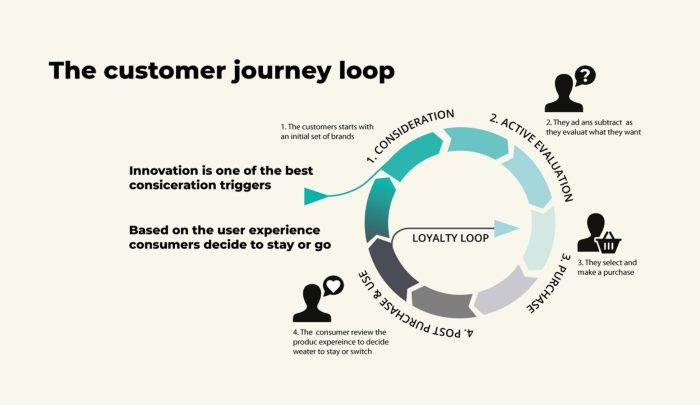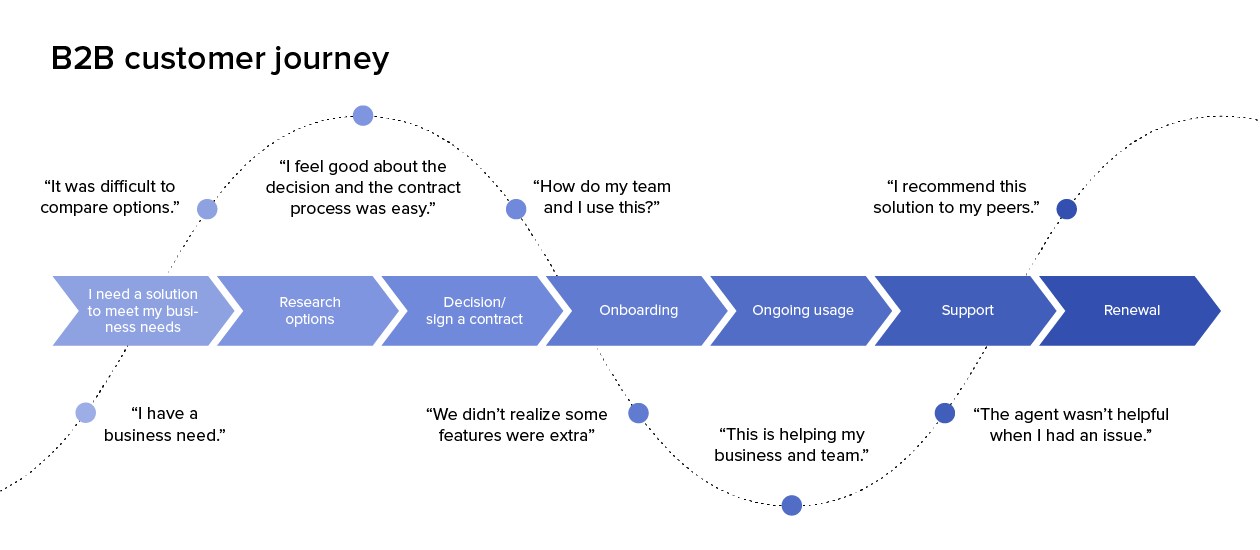Understanding the Customer Journey dives deep into the pivotal role of customer experiences in driving business success. From initial awareness to loyal advocacy, this journey shapes consumer decisions and brand loyalty in a dynamic marketplace.
Exploring the stages, mapping techniques, and optimal touchpoints, this comprehensive guide equips businesses with the tools to forge lasting connections with their audience.
Importance of Understanding the Customer Journey

Understanding the customer journey is crucial for businesses as it helps in creating a seamless and personalized experience for customers, leading to increased customer satisfaction and loyalty.
Enhanced Customer Engagement
- By mapping out the customer journey, businesses can identify touchpoints where customers interact with the brand, allowing for targeted and personalized communication.
- Understanding customer preferences and behaviors at each stage of the journey enables businesses to tailor their marketing strategies and offerings accordingly.
Improved Customer Retention, Understanding the Customer Journey
- Businesses that understand the customer journey are better equipped to address customer pain points and provide solutions, ultimately leading to higher customer retention rates.
- By anticipating customer needs and expectations throughout their journey, businesses can proactively address issues and ensure a positive customer experience.
Negative Impact of Not Understanding the Customer Journey
- Businesses that fail to understand the customer journey may miss out on opportunities to engage with customers effectively, resulting in decreased customer satisfaction and loyalty.
- Without insights into the customer journey, businesses risk delivering inconsistent messaging and experiences, which can lead to customer confusion and ultimately loss of business.
Stages of the Customer Journey
Understanding the different stages of the customer journey is essential for businesses to effectively engage with their target audience and drive sales. From awareness to advocacy, customers go through various phases that influence their purchasing decisions.
Awareness Stage
In the awareness stage, customers become familiar with a brand, product, or service. They may come across the company through social media ads, online searches, or word-of-mouth referrals. Examples of customer actions at this stage include visiting the company website, following social media pages, or signing up for newsletters.
Consideration Stage
During the consideration stage, customers evaluate different options before making a purchase decision. They may compare prices, read reviews, or seek recommendations from friends and family. Examples of customer actions at this stage include reading product reviews, comparing features, or requesting demos.
Decision Stage
In the decision stage, customers are ready to make a purchase. They may add items to their cart, proceed to checkout, or contact sales representatives for more information. Examples of customer actions at this stage include making a purchase, subscribing to a service, or booking an appointment.
Retention Stage
The retention stage focuses on keeping customers engaged and satisfied after the purchase. Companies may send personalized offers, provide ongoing support, or gather feedback to improve their products or services. Examples of customer actions at this stage include leaving positive reviews, referring friends, or joining loyalty programs.
Advocacy Stage
In the advocacy stage, customers become loyal brand advocates who promote the company to others. They may share their positive experiences on social media, participate in referral programs, or write testimonials. Examples of customer actions at this stage include recommending the brand to friends, sharing posts on social media, or attending company events.
Mapping the Customer Journey
Mapping the customer journey involves visualizing and understanding the steps a customer takes when interacting with a business, from initial awareness to post-purchase support. It helps businesses identify touchpoints, pain points, and opportunities for improvement in the customer experience.
Step-by-Step Guide to Create a Customer Journey Map
- Identify customer personas: Define the different types of customers who interact with your business.
- Map out touchpoints: Identify all the interactions a customer has with your business, both online and offline.
- Add emotions and actions: Include the emotions and actions of customers at each touchpoint to understand their experience.
- Identify pain points and opportunities: Highlight areas where customers may face challenges or where improvements can be made.
- Create a visual map: Use tools like customer journey mapping software or even simple pen and paper to create a visual representation of the customer journey.
Tools and Techniques for Mapping the Customer Journey Effectively
- Customer journey mapping software: Platforms like Smaply, UXPressia, or even tools like Miro and Lucidchart can help create detailed customer journey maps.
- Surveys and interviews: Gathering feedback directly from customers through surveys and interviews can provide valuable insights for mapping the customer journey.
- Data analysis: Utilize data from various touchpoints to understand customer behavior and preferences throughout their journey.
- Cross-functional collaboration: Involve teams from different departments like marketing, sales, and customer service to get a comprehensive view of the customer journey.
Touchpoints and Interactions: Understanding The Customer Journey

In the customer journey, touchpoints are the points of interaction between a customer and a business or brand. These interactions play a crucial role in shaping the overall customer experience and can significantly impact customer satisfaction and loyalty.
Significance of Customer Touchpoints
Customer touchpoints are essential as they provide opportunities for businesses to engage with customers, address their needs, and build relationships. By optimizing interactions at touchpoints, businesses can create a seamless and positive customer experience, leading to increased customer satisfaction and retention.
- Online Platforms: Websites, social media, and mobile apps serve as common touchpoints where customers interact with businesses digitally.
- Physical Locations: Retail stores, offices, and events are touchpoints where customers engage with businesses in person.
- Customer Service: Phone calls, emails, and live chat support are touchpoints where customers seek assistance and solutions from businesses.
Examples of Optimizing Customer Interactions
Personalization is key in optimizing customer interactions at touchpoints. By using customer data to tailor communication and offers, businesses can create a more personalized and relevant experience for customers.
- Implementing chatbots on websites to provide instant assistance to customers.
- Sending personalized email campaigns based on customer preferences and behavior.
- Offering loyalty programs that reward customers for their continued engagement and purchases.
